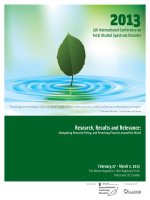- Trang chủ >>
- THPT Quốc Gia >>
- Hóa
Forests around the world
Bạn đang xem bản rút gọn của tài liệu. Xem và tải ngay bản đầy đủ của tài liệu tại đây (3.76 MB, 10 trang )
Genre
Nonfiction
Comprehension Skill
Text Features
Main Idea and Details • Captions
• Map
• Glossary
Science Content
Biomes
Scott Foresman Science 6.6
ISBN 0-328-13987-4
ì<(sk$m)=bdjihd< +^-Ä-U-Ä-U
Vocabulary
Extended Vocabulary
abiotic factor
biome
biotic factor
community
ecosystem
environment
population
canopy
conifer
coniferous forest
deciduous forest
dormant
hibernate
migrate
rain forest
understory
What did you learn?
1. Why do some animals in deciduous forests
hibernate?
2. What adaptations help conifers survive the
winter?
3. Why do few plants grow on the floor of the
tropical rain forests?
4.
The type of biome that exists
by
in an area depends
onCharles
its climate.Miller
What kind of
adaptations do trees need to make to take
advantage of differences in temperature and
light in various climates?
5.
Picture Credits
Every effort has been made to secure permission and provide appropriate credit for photographic material.
The publisher deeply regrets any omission and pledges to correct errors called to its attention in subsequent editions.
Photo locators denoted as follows: Top (T), Center (C), Bottom (B), Left (L), Right (R), Background (Bkgd).
Opener: Jon Arnold/Alamy Images; 1 Tim FitzHarris/Minden Pictures; 9 (B) Jon Arnold/Alamy Images;
12 (B) Frans Lanting/Minden Pictures; 15 Frans Lanting/Minden Pictures.
Unless otherwise acknowledged, all photographs are the copyright © of Dorling Kindersley, a division of Pearson.
ISBN: 0-328-13987-4
Copyright © Pearson Education, Inc. All Rights Reserved. Printed in the United States of America.
This publication is protected by Copyright, and permission should be obtained from the publisher prior to any
prohibited reproduction, storage in a retrieval system, or transmission in any form by any means, electronic,
mechanical, photocopying, recording, or likewise. For information regarding permission(s), write to
Permissions Department, Scott Foresman, 1900 East Lake Avenue, Glenview, Illinois 60025.
3 4 5 6 7 8 9 10 V010 13 12 11 10 09 08 07 06 05
Main Idea and Details What do you think is
the main idea of the second paragraph on page
14? Identify details that support the main idea.
What You Already Know
Every part of Earth’s surface, atmosphere, and oceans is
home to living organisms. An organism’s environment is all of
the things around it that affect how it lives and grows. The abiotic
factors of the environment include all of the nonliving things,
such as sunlight, air, water, and even temperature. The biotic
factors are the living parts of the environment. Both types of
factors are important to the survival of an organism.
The different species in a particular area interact with one
another and with the environment around them. A population
is a group of individual organisms of one species that live in an
area. Humans can be classified as part of a population. You are
part of the human population of your neighborhood, your state,
the entire country, and the Earth.
There are as many different populations in an area as there
are species. For example, a pine forest has a population of pine
trees, but it also has populations of many species of birds. A
community is a group of populations that interact with each
other in a particular area. The trees and birds are both part
of the pine forest community.
The entire community of living things and the nonliving
parts of the environment are called an ecosystem. Ecosystems
can be small, such as a dead log and the organisms that inhabit it.
They can also be an entire forest, including the dead log and its
inhabitants.
Similar ecosystems can occur in many places if environmental
factors are similar. For example, forests of pine trees exist in
many places in North America. Similar forest ecosystems occur
in many parts of Europe and Asia. A biome is a large group of
ecosystems with similar climates and organisms.
In this book you will read about three types of forest biomes.
You will learn about many of the populations of animals and
plants that live in these biomes.
2
3
Forest Biomes
What do you think of when you hear the word forest?
Although ancient forests were dominated by very tall ferns or
mosses, the main characteristic of a modern forest is its trees.
In a forest, trees provide food, shelter, and oxygen for many
communities of organisms. The types of organisms that live
in a forest ecosystem are often determined by the kinds of
trees that grow there.
A forest includes much more than just the trees, though.
The living parts of the forest—the biotic factors—also include
shrubs and grasses, mosses, and other plants. Animals, from
tiny insects to large mammals, depend on these plants and
affect how they grow. Microorganisms that break down leaves
into soil are an essential part of a forest.
Forests cover about thirty percent of the land surface
of Earth. There are three major types of forest: deciduous
forests, coniferous forests, and rain forests. Deciduous forests
have trees with wide leaves that fall off in the winter. They are
located in the middle latitudes of the Northern Hemisphere.
The main feature of coniferous forests is trees that produce
seeds in cones. Trees in coniferous forests have needlelike leaves
that remain on the trees throughout the winter. In general,
coniferous forests grow farther north than deciduous forests.
A rain forest grows where temperatures are warm and
where it rains throughout most of the year. Rain forests have
very dense plant growth and the trees do not lose their leaves
in the winter. Most rain forests are located near the equator
and are known as tropical rain forests. Along
the northwest coast of North America,
where the ocean causes some areas to
be warmer and wetter, there are some
temperate rain forests.
Forests Around the World
Deciduous
Coniferous
Rain forest
The forest biomes form rings around the
land masses of Earth.
Deciduous forests grow
rapidly, beginning new
growth each spring.
4
Coniferous forests
are adapted to the
cold, snowy areas
of the north.
In the rain forest
plants grow tall,
competing for
sunlight.
5
Deciduous Forests
Deciduous forests grow in the temperate regions, between
the cold polar area and the hot tropics. The plants and animals
in this biome have adapted to cold winters and hot, rainy
summers. If you live near a deciduous forest, you have seen
leaves like those pictured below. The trees have broad leaves that
gather a lot of light during the growing season. Leaves form a
canopy, which is a covering high in the trees that blocks much
of the light. The floor of the forest is covered with communities
of plants, such as azaleas and mosses, that have
adapted to decreased sunlight.
Trees use the light, heat, and moisture
of the summer to grow and produce seeds.
In autumn, when the amount of sunlight
decreases, the leaves stop producing
food for the tree, change color, and then
drop to the ground. When this happens,
the forest loses its canopy. If the leaves
remained on the tree all winter, enough
snow could collect on the leaves to break
Acorns and other
the branches. During the winter, the
deciduous tree seeds
provide food for many
trees become dormant, which means
animals, as well as
that they do not produce food or grow.
In the spring, before the
canopy returns, many smaller
plants, such as the bluebells in
the photograph on this page,
use the extra sunlight to grow
rapidly on the forest floor.
Many small forest plants flower
early in the growing season
before the canopy is complete.
Within the canopy, insects
and caterpillars feed on the
nutrient-rich leaves. In turn,
they become meals for warblers
and other birds that live in the
canopy. The sounds of insects
and songbirds give the forest a
feeling of constant activity.
start new trees.
Leaves changing color at the
end of the growing season is
a sign of a deciduous forest.
6
7
Many different kinds of animals live in a deciduous
forest. The decaying leaves on the ground provide
nourishment for mushrooms and other fungi. The leaves
are also home and food for animals such as insects and
worms. Other small animals—toads, spiders, moles, and
birds—eat the plants and animals on the forest floor.
Larger animals that are common in this biome include
skunks, raccoons, coyotes, deer, and bears.
After the trees lose their leaves, the food supply
of the deciduous forest decreases until spring growth
begins. Forest animals have to adapt to this shortage.
Some birds and butterflies fly to warmer climates
until the spring brings new food. Some animals
move to a sheltered place. During the winter their
body functions slow down, or they enter a similar
state resembling sleep. Other animals, such as
squirrels, chipmunks, and blue jays, store extra
food in the warm months and then retrieve it
in winter.
Coniferous Forests
Coniferous forests are located in a band around
the northern parts of the continents of North
America, Asia, and Europe. The organisms of
these forests must be able to survive long, very
cold winters. Most of the trees in these forests
are conifers—trees that have long, narrow,
evergreen leaves, often called needles. These
leaves have waxy coatings that decrease water
loss in the winter, when the frozen ground
keeps the tree from getting water. Conifers
include pines, spruces, and firs. They
are called conifers because they
produce cones instead of flowers.
Look at the photograph at the
bottom of the page. You can see that
all the trees have a similar shape—wide
at the bottom and coming to a point at
the top. Can you think of a reason why that is a
good shape for a tree in a place with heavy snow?
The needleshaped leaves
and the cone full
of seeds show
that the stone
pine is a conifer.
This woodpecker
finds insects inside
trees, digging
them out with
its strong beak.
Deer eat low-growing plants,
acorns, and young trees.
8
9
The shape of conifers is one adaptation to the cold,
snowy climate. The branches bend downward and snow falls
off the tree before it becomes heavy enough to break the
branches. The needles usually are a dark color that absorbs
the maximum amount of heat from the Sun, and they do
not fall off the tree in winter. Because the summers are short,
this allows the plant to start photosynthesis as early in the
spring as possible.
The trees in a coniferous forest tend to grow close
together and are very densely covered with needles. Because
of this few plants grow on the ground. Mosses and lichens
are common, but flowering shrubs are rare. Many insects and
fungi live in the bark of the trees or in decaying logs of dead
trees. Fungi, important decomposers in these forests, are also
eaten by insects and other animals. One of the main sources
of food for animals in the forest is the seeds produced in the
cones of the trees.
Bears of the coniferous
forest grow fat from
eating smaller animals,
seeds, and berries,
and then they
are inactive
all winter.
Birds of prey, including this
American kestrel, thrive on
the many small animals that
live in ponds and bogs.
Even in areas with little
rain, the northern forests still
have a lot of ponds and bogs. In
spring, the melting snows provide a
lot of water, which evaporates slowly in the cool climate.
The wet environment is the perfect home for a large insect
population. Many species of birds, such as grosbeaks,
flycatchers, and warblers, fly to the northern coniferous
forests in summer to feast on these insects. When the
weather becomes cold, these birds migrate, or move from
one place to another, flying south to a warmer climate for
the winter. Many seed-eating birds, such as finches and
sparrows, stay all year long.
Other animals of the forest adapt to the cold winters in
several different ways. Some, such as hares and other small
mammals, burrow underground during winter to escape
the cold. Others, such as bears and bats, store food in their
bodies as fat in summer and autumn, when there is a lot
of food, and sleep during much of the winter. Wolves,
mink, and wolverines grow thick winter coats so
they can hunt even in cold weather.
Many predators, such
as this bobcat, grow a
thick, insulating coat
for the winter.
10
11
Rain Forests
The tropical rain forests make up a hot, wet biome located
near the equator all around the world. In this climate, plants
grow all year round, with no dormant period. Instead of summer
and winter, the tropical seasons are the rainy season and the dry
season. The temperature never drops below freezing. As you can
see in the photo, the rain forest is full of lush, green growth.
The tropical rain forest grows in layers. The upper canopy is
formed by trees that grow up to 130 feet tall. In the emergent layer
giant trees grow sparsely to about 250 feet tall. Thick vines climb
up the trunks of the trees into the canopy and compete with the
trees for sunlight. Below the canopy is the middle layer, called the
understory, made of vines, smaller trees, ferns, and palms. Many
of the plants have huge leaves to capture as much light as possible.
The rain forest contains
layers of plants that
compete for sunlight.
The canopy and understory are home
to an incredible number of plants and
animals, many of which never leave the
trees. Some plants, including orchids and
bromeliads, live in the trees, collecting
nutrients from small pockets of
decaying leaves. Colorful birds such as
toucans and parrots, large butterflies
and moths, and a wide variety of small
reptiles and mammals move through
the canopy looking for food and
protection from predators. There are so
many species in the rain forests around
the world that scientists are constantly
discovering new ones.
The bottom layer of the rain forest
has very few plants because so little light
reaches the forest floor, which is covered with
wet leaves and decaying plants. The hot and
moist environment is the perfect place for
fungi, bacteria, and other microorganisms.
Large insect populations also live on the
forest floor.
Many exotic birds,
such as parrots, live
in the canopy of
the rain forest.
The warm, wet climate of
the rain forest is perfect
for boa constrictors and
other reptiles.
12
13
Forests at Risk
This squirrel
monkey’s tail is
useful for life in
the branches.
Many primates, such as monkeys and apes, live among the
trees. Large mammals, such as hippopotamuses, rhinoceroses, and
even elephants, live on forest floors. Large cats, including jaguars
and leopards, prey on other animals, from frogs to antelope.
Rain forest animals have many interesting adaptations.
Toucans and parrots have beaks that are designed for particular
types of food. Some insects and reptiles protect themselves by
making poisons. Poisonous animals are often very brightly
colored, so that a predator knows they are dangerous.
Chameleons change the color of their body to blend
into their environment and hide from predators.
The sloth, which lives in the South American
forests, moves slowly through the trees. It hangs
upside down looking for fruit. Algae grow
in the sloth’s fur, giving it a green color and
making it difficult to detect.
The red-eyed tree frog has huge,
brightly colored eyes that scare
away predators.
14
The type of forest that grows in a particular region
depends on its climate. In the coniferous forests of the far
north, success depends on developing a way to survive the
winter. In the deciduous forests, many of the plants and
animals take advantage of the changing seasons. The tropical
rain forests provide food and shelter to more species than
any other biome on Earth.
The central part of any forest is its trees. Unfortunately,
many of the world’s forests have disappeared or are threatened.
Half of the tropical rain forests have been cut down in the
last half century. Some of them have been cut for lumber and
others to provide farmland. Because of the large number of
different species and how they interact, it is almost impossible
to restore a tropical rain forest that has been cleared. Many
coniferous forests have also been cut down for lumber, paper
manufacturing, and other wood
products. Once the trees have been
removed, erosion of the land by
wind and water can cause problems
that make it hard for the forest
to regrow. Most of the original
deciduous forests have been cut
down for lumber and to clear fields
for farming. Because this type of
forest grows quickly, many of these
forests have recovered, but without
careful controls, even these forests
are at risk.
Hidden beneath the canopy
of this rain forest live an
incredible number of plants
and animals.
15
Vocabulary
Glossary
Extended Vocabulary
abiotic factor
biome
canopy
biotic factor
community
ecosystem
environment
conifer
population
canopy
conifer
a covering of leaves high above the
coniferous forest
forest floor that absorbs most
deciduous forest
of the sunlight
dormant
hibernate
a tree that produces seeds in cones and does
migrate
not flower
rain forest
understory
coniferous forest the forest of the north, centered around
conifers and adapted to long, cold winters
What did you learn?
1. Why do some animals in deciduous forests
hibernate?
2. What adaptations help conifers survive the
winter?
3. Why do few plants grow on the floor of the
tropical rain forests?
4.
The type of biome that exists
in an area depends on its climate. What kind of
adaptations do trees need to make to take
advantage of differences in temperature and
light in various climates?
5.
Main Idea and Details What do you think is
the main idea of the second paragraph on page
14? Identify details that support the main idea.
deciduous forest the forest of the temperate regions, in
which trees lose their leaves and stop
growing in winter
dormant
that does not grow or produce food
hibernate
to be in an inactive condition in which the
body functions slow down
migrate
to travel to a different biome
rain forest
the forest of the tropics, which is in continual
growth and has the most diversity
Picture Credits
Every effort has been made to secure permission and provide appropriate credit for photographic material.
The publisher deeply regrets any omission and pledges to correct errors called to its attention in subsequent editions.
Photo locators denoted as follows: Top (T), Center (C), Bottom (B), Left (L), Right (R), Background (Bkgd).
understory
the layer of plants growing between the forest
floor and the canopy
Opener: Jon Arnold/Alamy Images; 1 Tim FitzHarris/Minden Pictures; 9 (B) Jon Arnold/Alamy Images;
12 (B) Frans Lanting/Minden Pictures; 15 Frans Lanting/Minden Pictures.
Unless otherwise acknowledged, all photographs are the copyright © of Dorling Kindersley, a division of Pearson.
ISBN: 0-328-13987-4
Copyright © Pearson Education, Inc. All Rights Reserved. Printed in the United States of America.
This publication is protected by Copyright, and permission should be obtained from the publisher prior to any
prohibited reproduction, storage in a retrieval system, or transmission in any form by any means, electronic,
mechanical, photocopying, recording, or likewise. For information regarding permission(s), write to
Permissions Department, Scott Foresman, 1900 East Lake Avenue, Glenview, Illinois 60025.
3 4 5 6 7 8 9 10 V010 13 12 11 10 09 08 07 06 05
16









